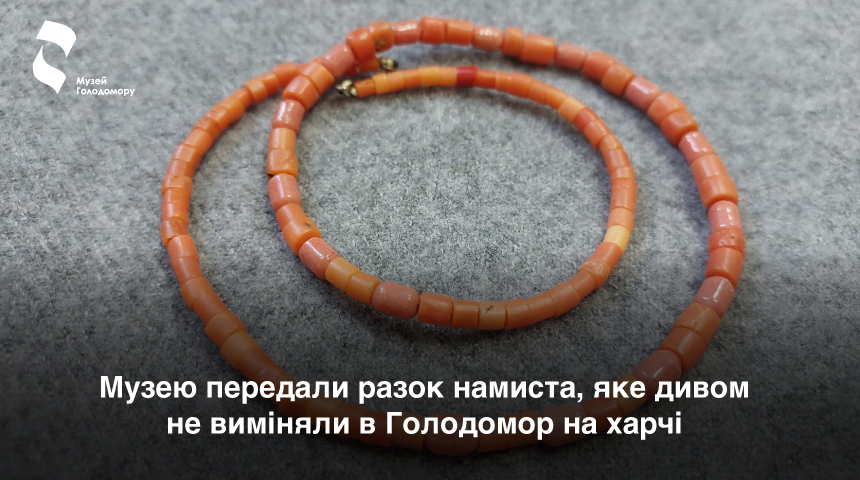“Father with tears in his eyes showed where our land was”
It all started with a comment on Instagram on the krapka.krapka page
One of Tetiana’s readers reacted to the photo of the blogger’s necklace, noting that there are so few family heirlooms in Ukrainian families because people had to exchange them for food in 1933 and 1947.
krapka.krapka contacted the woman with our museum, and already on Sunday, February 11, Tetiana and her mother, Sofia Panteleimonivna, visited the Holodomor Museum.
Kulykovska (Zholob) Sofia Panteleimonivna, born in 1940, was born in the Poltava region in the village of Tarasivka, Zinkiv district. She remembers well the stories of her mother, relatives and fellow villagers about the Holodomor.
The Zholob family, in which Sofia Panteleimonivna was the youngest child, was engaged in agriculture at the beginning of the 20th century. Two sons were born to the young family of Panteleimon and Yelyzaveta in 1927 and 1929. They farmed and lived at the expense of hard work on the fertile Ukrainian chernozems.
Under the NEP (New Economic Policy), in conditions of conscientious work, it was possible to feed a family and support a household. This is what the Ukrainian farmers tried to use. However, already from the end of the 1920s, it became harder and harder to survive. The family of Aunt Sofia Panteleimonivna, Uliana, was evicted like kulaks to the village Zholoby, where the conditions for survival were the worst.
Forced collectivization did not bypass anyone. Panteleimon Yefremovych Zholob’s father resisted collectivization to the last, but already in 1933, his horse and goat were taken to the collective farm. It was unbearable for the man to look at his horse already in the collective farm stable – dry and starved. He also mourned for the selected land. “With tears in his eyes, my father showed us where our land was,” the woman recalls.
Sofia Panteleimonivna’s family survived in 1932-1933 thanks to their dukachs, earrings and necklaces. Father went to exchange these precious pieces of jewellery for food in another village, which was located 25 kilometres from Tarasivka, and mother, Yelyzaveta Efremivna exchanged earrings and beads for grain from the guard of the collective farm pantry. The building, where the grain was transported to, was located directly in the village, the grain was rotting there, but no one had the right to take it, despite the mass mortality from hunger. Mother, in order to survive, had to exchange all the jewellery with the guard, leaving for herself only one earring and a single (strip) of beads. Yelyzaveta Efremivna decided to tell this story of salvation to her granddaughters at an older age. Thanks to these exchanges, Panteleimon and Yelyzaveta Zholob’s family managed to survive.
Carriages with the corpses of starving people became a familiar phenomenon for Tarasivka, recalls the words of parents and relatives Sofya Panteleimonovna. The Holodomor was a terrible tragedy for Aunt Uliana’s dekulakized family. In 1932-1933, four of her children died of starvation.
Sofia Panteleimonivna, born after the Holodomor, was also affected by the famine. In 1947, when she was in the first grade, there was the height of the post-war mass man-made famine. It was lunches at school that became the salvation for Sofiyka.
Such a tragic story, which, regrettably, was typical for the years 1932-1933, was shared with us by Sofiia Panteleimonivna and transferred to the museum funds for safekeeping once a mother’s necklace, which became a symbol of both grief and survival at the same time.
We are sincerely grateful to @krapka.krapka for help in communication and concern for the Holodomor history. At the same time, we appeal to all Ukrainians: if you have preserved photos, documents or any other things related to the Holodomor-genocide period, write to us at the e-mail of the museum [email protected], in private messages on our Facebook page or call +38 044 254 45 12. Each such thing is priceless and should be preserved.
